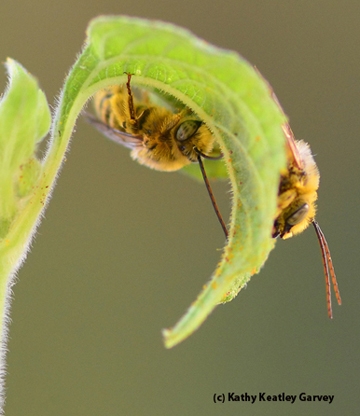
Just call them "snuggle bugs."
Or "snuggle bees."
After spending the day chasing the girls and defending their patch of Mexican sunflowers or Tithonia, a cluster of Melissodes robustior males settled down for the night.
Their bed last night: a Tithonia leaf curl. Before that, some lavender stems. Before that, a Tithonia blossom.
The occasion: Boys' Night Out. While the girls sleep in their underground nests, the boys find a comfortable and presumably safe place to get some shut eye.
Last night a single male chose the bed, and soon half a dozen others joined him. They are territorial during the day, but at night, it's all fuzzy wuzzy, peace 'n harmony, and "brotherly love."
Meanwhile, a European paper wasp flew by, its legs dangling, and a nearby garden spider crawled to the edge of its web and checked out the sleeping boys.
Melissodes is just one of the bees mentioned in the book, California Bees and Blooms: A Guide for Gardeners and Naturalists (Heyday). It's the work of the University of California-based team of Gordon Frankie, Robbin Thorp, Rollin Coville and Barbara Eritter, all of whom are linked to UC Berkeley, past or present (Thorp, a distinguished emeritus professor at UC Davis, received his doctorate at UC Berkeley.)
The authors point out that there are 130 Melissodes species in the New World, "predominantly in North America, which is home to approximately 100 of these."
Fifty Melissodes species have been found in California alone. "Only (the) species, M. robustior, M. tepida timberlakei and M. lupina are widespread and common," they write.
Our Vacaville bee garden annually draws dozens of Melissodes robustior to the Tithonia.
Widespread and common? Yes, at least in our little bee garden.
Attached Images:
